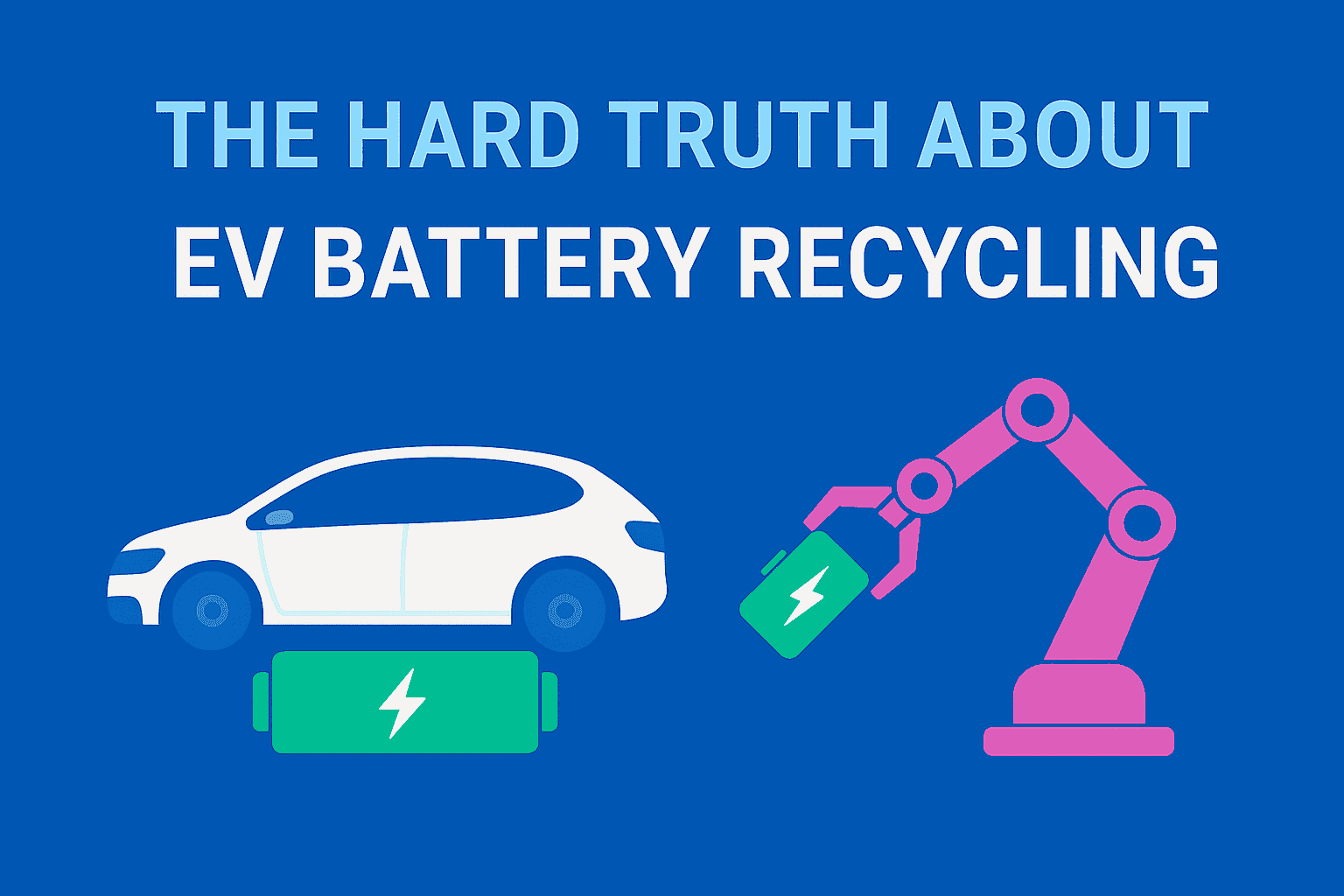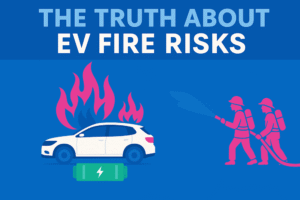EV Batteries Are Not Like iPhone Batteries…
I continually see comparisons made between ‘harmless’ mobile phone batteries and EV battery packs, but the reality is that they are very different. The average EV battery pack is roughly 45,000 times larger in volume and 11,000 times heavier than the lithium-ion battery in an iPhone. While both iPhones and EVs use lithium-ion technology, the scale and chemistry make EV batteries far more volatile. A phone’s small lithium cobalt oxide cell stores only a few watt-hours of energy, whereas an EV battery pack contains thousands of larger cells, often using nickel-rich chemistries like NMC (Lithium Nickel Manganese Cobalt Oxide) or NCA (Lithium Nickel Cobalt Aluminium Oxide), and storing 50-100 kWh.

Sophisticated Battery Management Required
This huge energy density, combined with the risk of thermal runaway spreading between cells, means EVs require complex battery management systems (BMS) to ensure safety. These software systems constantly monitor temperature, voltage and charge levels. BMS also balances the cells, to keep them at the same voltage and state of charge, and manages functions such as thermal preconditioning before charging, cooling under heavy load and safe shutdown in emergencies. All of this is done to minimise the risk of fire or damage that just isn’t a present risk or danger with most small mobile devices.

Limited Recovery of Precious Metals
Low Yields, High Risk
Recycling lithium-ion batteries is often assumed to be easy and highly effective, and from my experience reading social posts by EV drivers, it seems so simple that everyone is doing it. The reality is very different from the misinformed perception. The truth is, EV battery recycling is a very difficult and hazardous activity, with current recovery rates varying widely and typically falling short of expectations. For example, Wikipedia quotes: “modern recycling processes recover only 25% to 96% of a lithium-ion battery’s material.” That is such a broad range that it serves to be nothing more than meaningless, but it does underscore the variability and complexity of the process. A 2019 benchmark revealed that just 5% of end-of-life EV batteries were recycled globally, highlighting a massive gap between expectations and reality. Europe’s recycling infrastructure could support up to 2 million EVs by 2030, yet due to high energy costs and financial barriers, current capacity supports only 10% of what’s needed. In the United States (US) the number is even lower, with only around 5% of EV batteries currently recycled each year.
Why Recycling is Financially Challenging
Recycling lithium-ion batteries seems like a lucrative idea, as critical metals like cobalt and lithium are expensive, but the recycling process is expensive, complex and not without risk. Recyclers face low yield rates, with the recovered materials barely offsetting labour, energy and operational costs (sorting, shredding, neutralisation, smelting, purification). Cost estimates suggest processing a Tesla Model S battery could cost around $3,000, a steep investment that often outweighs the resale value. Some startups, like American Manganese and Li-Cycle, forecast net profit margins of 50-60% by optimising processes and scaling operations, though such success stories are still rare.
The Science: Hazardous and Energy-Heavy Methods
Extracting valuable metals safely from batteries involves dangerous, energy-intensive steps. Methods include pyrometallurgy (smelting with high heat), which often loses lithium, aluminium, graphite and manganese and incurs high CO₂ emissions. Hydrometallurgy is better at recovering materials, uses large volumes of acid and solvents that produce toxic wastewater. Even unpacking battery packs carries serious risk: if the cell’s electrolyte is exposed, it may ignite or explode. Some researchers are pursuing “direct recycling”, where the cathode is reassembled for reuse. This method has higher potential yields and lower energy usage but remains experimental.
The Fenix Facility Disaster in Scotland
One telling example of recycling gone wrong is the aptly named Fenix Battery Recycling plant in Kilwinning, North Ayrshire. A devastating fire broke out on 8 April 2024, prompting a multi-agency emergency response, evacuations and a police investigation. Residents were urged to shelter indoors due to toxic fumes. The site, which had lost its waste management licence, was abandoned by operators, leaving piles of lithium batteries unattended. Exactly one year later, on 9 April 2025, the site caught fire again in a second blazing incident. Residents said the explosions sounded like a “terror attack,” and the event invoked trauma from the previous year.


Terrified residents described ‘dodging batteries as they flew like missiles’ after the recycling plant exploded yards from their homes for the second time in a year. The official report states the fire was likely triggered by leaking batteries at the abandoned site, which began to spontaneously combust (leakage-induced thermal runaway). Thankfully, no fatalities were reported, but the psychological and health impacts were substantial. Local homes were evacuated, and public safety warnings were issued against picking up battery debris.
The Success Stories
The Fenix disaster underscores the danger of lithium-ion battery mishandling, especially when proper regulatory and financial structures fail. However, some successful EV battery recycling operations do exist:
- In Europe, Hydrovolt (Norway) can process up to 12,000 tons annually and says it plans to scale to 70,000 tons in 2025 and 300,000 tons by 2030.
- In North America, Redwood Materials (Nevada) is another success story, recycling US lithium-ion batteries and aiming to produce 100 GWh of cathode active material annually by 2026.
Yet overall, the number of profitable lithium-ion battery recyclers remains small. Many facilities struggle to balance operational costs, safety protocols, energy requirements and regulatory compliance.
Environmental and Circular Economy Impact
So, what happens to the tens of thousands of tonnes of battery packs that aren’t recycled? In 2020, there were approximately 11 million EVs on the road, with projections suggesting that there will be 145 million by 2030; however, the market for EVs seems to be faltering in 2025 as consumer preference shifts back to petrol and diesel. As these batteries retire, huge volumes of spent packs, which could be as much as 250,000 tonnes worth by 2050, could accumulate without proper recycling. EU regulations mandate a minimum of 45% of batteries be collected and 50% recycled, with some targets exceeding 90% for metals like cobalt. Recycled materials can reduce dependence on new mining and help avoid the necessity to build new mines.
Recycling Batteries is Not as Easy as People Think
Battery recycling matters, but it’s nowhere near simple. Recovery efficiencies vary widely (25–96%) but are barely half of where they need to be, and many batteries go unrecycled. Commercial success remains elusive, and few recycling centres operate profitably, with Redwood and Hydrovolt notable exceptions. Safety is paramount, but fires, toxic byproducts and complex high-energy processing make it a high-risk industry. Examples like the Fenix plant show what happens when abandonment meets hazardous materials, risking lives and trust.
Government Health Warning
Scaling responsible recycling is an urgent need, both for environmental sustainability and for securing future mineral supplies under circular economy principles. Investing in safe, efficient and economically viable recycling infrastructure must be a priority, especially if governments are to continue with their misguided EV mandates. Otherwise, we risk more catastrophic events, especially when end-of-life battery packs go into waste systems, potentially causing health and safety hazards.
EVs Are Not So Kind to the Environment
When EV battery packs aren’t recycled, they often end up in long-term storage, shipped overseas or illegally dumped in landfills. Stockpiled batteries can degrade over time, increasing the risk of thermal runaway and fires, as seen in several recent recycling site incidents. Improper disposal can also lead to toxic leaching of cobalt, nickel, manganese and other hazardous materials into soil and groundwater, posing long-term environmental and safety risks.
Where Do EV Battery Packs Go?
Globally, less than 12% of retired EV batteries were recycled in 2023, with many instead exported to low-regulation countries for unsafe, informal dismantling or stripped for valuable parts, while the rest is discarded. Only a small proportion, of around 5-7%, are repurposed for second-life uses, such as stationary energy storage, and even these will eventually require proper recycling. Without a significant increase in recovery capacity, the growing volume of unprocessed battery packs will amplify fire hazards, pollution and resource loss in the years ahead.
You may want to read: “The Truth About EV Fire Risks.”







